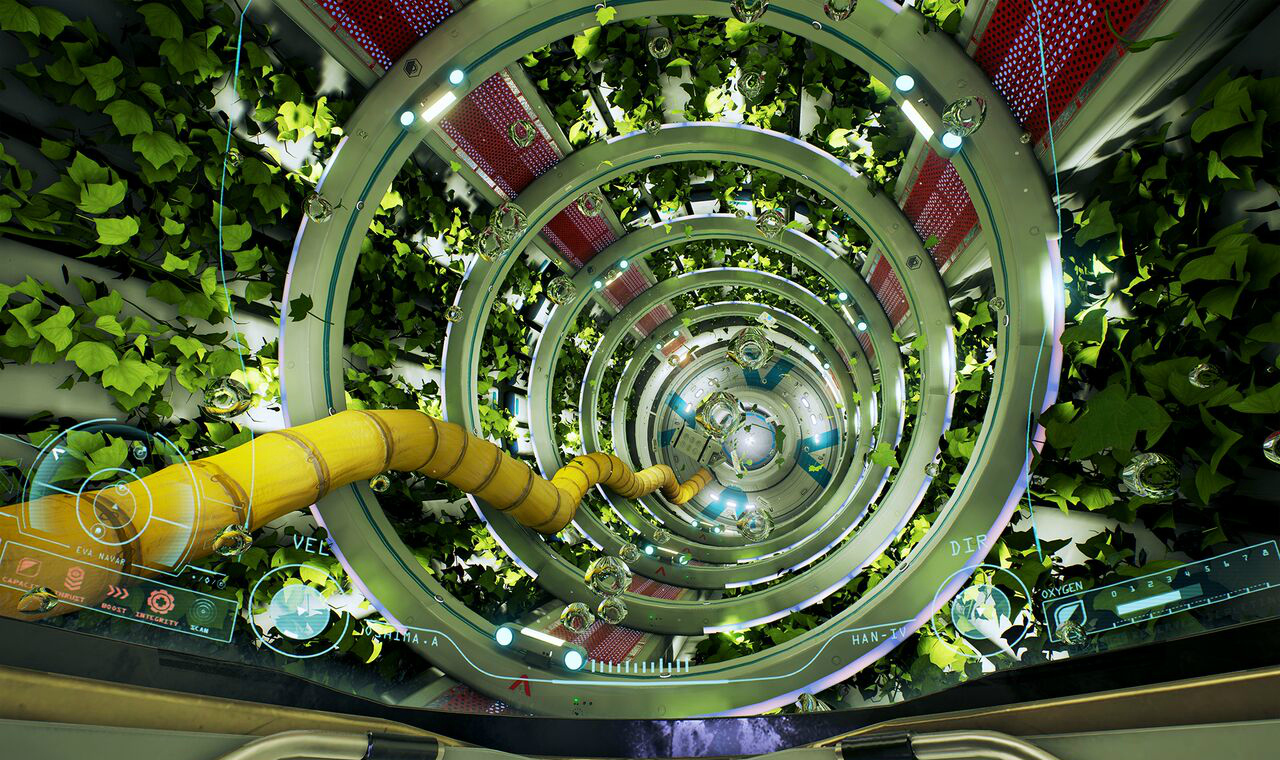Our past follows us, across borders, between cities--even into the infinite dark of space. And here, 462,000 kilometers above Australia, in the isolation and silence of their vacuous environment, the personal demons of Adr1ft's astronauts return to haunt them.
Adr1ft opens on the Han-IV, a a space station shattered in the aftermath of a horrific accident. We inhabit the space suit of Commander Alex Oshima as she tries to discern what went wrong, how she can fix it, and whether anyone else survived. Through audio logs and clues in the Han-IV's silent halls, however, we discover problems that existed long before the station's sudden catastrophe.
This is Adr1ft's greatest strength: Its characters may be on a mission of massive scientific importance--synthesizing life in an environment where life should be impossible--but their Earthly problems haven't left them. It's these fears, and the hope that staves them off, that lend a personal angle to what could have been an inhuman tale.
But that narrative is obscured by poor game design and pervasive boredom. Adr1ft's zero-gravity environments require you to float through the corridors and laboratories of the Han-IV using your suit's thrusters, and at first, it feels novel--there's a sense of verticality that comes when gravity ceases to exist. But movement soon becomes a slog when you know where you want to go, but can only progress at a snail's pace.
Furthermore, touching a wall, however lightly, damages your suit and requires fixing at specific repair stations. Adr1ft even introduces late-game electrical hazards that send you reeling into space with little warning. There's also the matter of your oxygen. As you drift through the Han-IV's decrepit corridors, your O2 reserves gradually deplete, until you find the next canister or refill module. But because of the abundant canisters strewn along your path, your reserves almost never deplete. These survival aspects feel forced. They don't increase the game's challenge, instead becoming an annoyance, and detracting from the story at hand.
The game's radar doesn't improve the experience, either. Despite the fact that Adr1ft takes place in a zero-gravity environment, with hallways stacked on top of one another, and branching corridors that twist and turn on a whim, the radar's objective arrow fails to adjust to your elevation. Several times throughout my playthrough, I floated slowly along one path for several minutes, only to discover my objective was dozens of feet below me, past several layers of the station's insulatory exterior.
If Adr1ft took place on a flat plain with normal gravity, the radar's simple objective indicator might be effective. But Adr1ft unfolds in a very different environment than those of most games. And its capricious heads-up display fails to adapt to its own setting.
Adr1ft's mechanics clash with each other in myriad ways.
Herein lies Adr1ft's Shakespearean flaw: its systems clash with each other in myriad ways: the survival aspects discourage lengthy exploration. The tedious movement destroys the pacing. The ineffective HUD creates problems at every turn, burying the story in frustration and unclear direction.
It's a shame, because Adr1ft is a gorgeous game, with moments of stunning beauty: the view of Asia at night from a quarter million miles away. Small droplets of water suspended in a silent interstellar greenhouse. The vast expanse of space, laid out before you with its multitudes of distant stars. There are macabre moments, too, among the Han-IV's scattered debris. But even here, there's an alluring sense of mystery.
That feeling is exacerbated when playing Adr1ft in VR. Textures are grittier with the Oculus, and minute details, such as the notes on characters' desks, are almost illegible in some cases. But there's a real sense of height and location that comes with the 360 degree views in virtual reality. Glancing around a botanical lab, or into the distant cities of Australia, becomes a much more engaging visual experience when it's surrounding you. It's one less layer of removal to deal with throughout the experience of exploring the space station.

Adr1ft's characters aren't immune to these vistas, either. They struggle with substance addiction, impostor syndrome, marriage problems, and interpersonal conflicts. But they push onward, trusting the notion that life can be beautiful. Adr1ft reveals small details that change your perception of these explorers' relationships and regrets. Like their shattered space vessel, they're all broken in their own ways. In digging below the surface, examining the mistakes these characters have made, and finding retribution among the guilt, Adr1ft tells a human story in a very inhuman setting.
"I'm coming back in, and it's the saddest moment of my life." One of Adr1ft's astronauts recites this famous line from astronaut Edward Higgins White, the first American to perform a spacewalk outside of any protective structure. The character then confesses how little his time in space has changed him. It didn't impart any profound connection to the human race. It just made him lonelier.
Adr1ft has an emotional story hiding below its surface. But that surface is coated in laborious movement, forced survival mechanics, and an obtrusive user interface. The characters all have stories to tell, and by plot's end, they've reached profound realizations about their pasts, and how they need to change as they move forward. But unlike its characters, Adr1ft fails to find the meaning hidden among the wreckage.